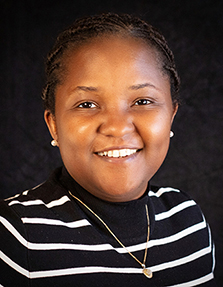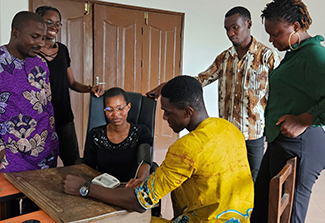Culturally relevant meal plans lead to better health
July/August 2025 | Volume 24 Number 4
 Photo courtesy of Halimatou AlaofèHalimatou Alaofè, PhD
Photo courtesy of Halimatou AlaofèHalimatou Alaofè, PhD
Standard nutrition advice often fails to resonate with local preferences and practices in lower-income nations. Unfortunately, this leads to poor diet adherence and suboptimal health outcomes, says Halimatou Alaofè, PhD, associate professor at the University of Arizona.
Alaofè’s
International Research Scientist Development Award project in her native Benin aims to “bridge that gap between advice and practice by designing a culturally relevant, sustainable nutrition intervention that can empower patients in low-resource settings to improve their dietary adherence.”
Specifically, her research focuses on long-term nutritional management of type 2 diabetes, which develops when the body cannot use insulin correctly, leading to excess sugar in the blood, in turn causing damage to the eyes, kidneys, nerves and heart.
Tailored plans
An alarming increase in type 2 diabetes-related illness and mortality is occurring in Benin, a west African country that borders Nigeria and sits just south of the Sahara. Diabetes prevalence has quadrupled in this French-speaking country of 14.7 million people, from 3% to 12.4% over the last decade, reaching as high as 22% in some regions. The negative effects impact not only those who live with the condition, but also their families and the healthcare system, says Alaofè.
Small scale studies of nutritional interventions for type 2 diabetes conducted in Benin have found very low adherence to the recommended diet. “Just 20%, but it might be even lower,” says Alaofè, who suspects that the suggested food plans are difficult to adhere to or unacceptable for patients. When developing a dietary intervention, researchers need to include general guidelines yet also consider the many additional factors that encourage uptake of an eating plan.
For example, medical nutrition therapy, which is formulated by a registered dietitian or nutritionist, helps patients manage specific health conditions. The evidence-based process begins with a clinical assessment, followed by a diagnosis and intervention plan, and then requires monitoring. For this to work, personalization is required.
“Culturally tailored nutrition therapy has proven particularly effective with type 2 diabetes. It recognizes the connection between food, dietary habits, and culture, and understands that effective behavior change necessitates that an intervention be both meaningful and relevant to each patient,” says Alaofè. In short, food preferences and cultural beliefs are baked into each individual plan.
Challenges
Alaofè sees a chasm between the official guidelines and actual patient behavior. When listening to people, she often hears a “lack of awareness at the patient level, but also at the healthcare provider level.”
Before beginning her IRSDA project, she conducted formative research which included focus group interviews with stakeholders. She found that nutritionists too often “present the idea that Benin doesn’t have good local resources. But it's not true. We have seasonal fruits and vegetables and many of our national dishes are vegetable-based.” Seeking to change this, Alaofè has incorporated into her project research on how best to use local foods.
Her formative research has also shown her that patients don't want to participate in projects delivered via healthcare systems because “healthcare means death. Can you imagine? If you provide a service at the healthcare level, the population will never come and listen to you,” says Alaofè.
Insufficient patient interaction also leads to out-of-touch recommendations, which she’s seeking to alter. “For example, we still say, ‘eat five portions of fruit and vegetables.’ We still say, ‘one spoon of oil.’ What does that even mean, when in Africa the food is shared?”
 Photo courtesy of Halimatou AlaofèDieticians learn to measure blood pressure
Photo courtesy of Halimatou AlaofèDieticians learn to measure blood pressure
During a patient focus group, Alaofè asked,
Why don’t you eat more fruits and vegetables?
The answer: “Fruits and vegetables are for the poor. When you have a guest, you have to put out a rice dish or spaghetti.” Carb-based, westernized food confers prestige, she notes.
“In the media, everywhere, nutritionists talk about obesity and a good diet, but how do you convince people to eat good food, when they believe that eating a particular carb means they belong to a higher status?”
Having examined perceptions of obesity and willingness to lose weight, she found that people reject the negative connotations of “obesity” because for them, weight “is related to wealth and to attraction and to fertility. Women say, ‘I have to gain weight when I'm pregnant,’ so how do I convince those who are overweight to lose pounds to help with glycemic control [lowering blood sugar]?”
Nutritional communication strategies need to change, says Alaofè. “We need to adjust so our patients don't run from us.”
Family matters
“My interest in nutrition was driven by witnessing the impact of poor dietary habits and food insecurity on maternal and child health in underserved populations,” says Alaofè, whose bachelor’s degree in biomedical science allowed her to work as a lab technician in both rural and urban areas in Benin. “I saw firsthand how nutrition intersects with disease prevention and long-term health outcomes, and this inspired me to pursue advanced training in nutrition.” She hopes to better understand the biological, social, and policy dimensions of diet, while contributing to evidence-based solutions to improve population health.
Fogarty’s commitment to international work led her to the IRSDA program, which provides support and protected time to U.S. postdoctoral scientists and junior faculty for career development. “I applied to gain mentoring and research experience, to strengthen my own capacity.” Alaofè believes her project will be relevant to many U.S. citizens who underwrite this funding. “Ethnic minorities communities such as African Americans and Hispanic/Latino individuals with unique dietary patterns, traditional foodways, and health beliefs. We also have low health literacy and under-resourced communities facing food insecurity who need help to access adequate and nutritious food.”
Although her project is not yet complete—it will end in 2027—Alaofè has already published three papers.
One demonstrates the value of a diet that meets the four A framework of food security: availability (is there enough), accessibility (in the right place), affordability (for the whole population), and adequacy (for a nutritious diet). The
second paper examines best practices for engaging social networks in nutrition interventions. The
last paper shows how both culture and family relate to diets.
“Most people die due to undernutrition, not because of the diabetes—they die because they don't know what to eat. Families don't know how to support the patient, so we have to help them do that.”
It’s not necessary to require the entire family’s constant participation, but family members need to be invited along whenever there’s crucial information to be shared, says Alaofè. “People become isolated when they have diabetes. They feel they have to solve it alone, when, really, they need the support of their families.”
More information
Updated August 20, 2025
To view Adobe PDF files,
download current, free accessible plug-ins from Adobe's website.
Related Fogarty Programs
Related World Regions / Countries
Related Global Health Research Topics